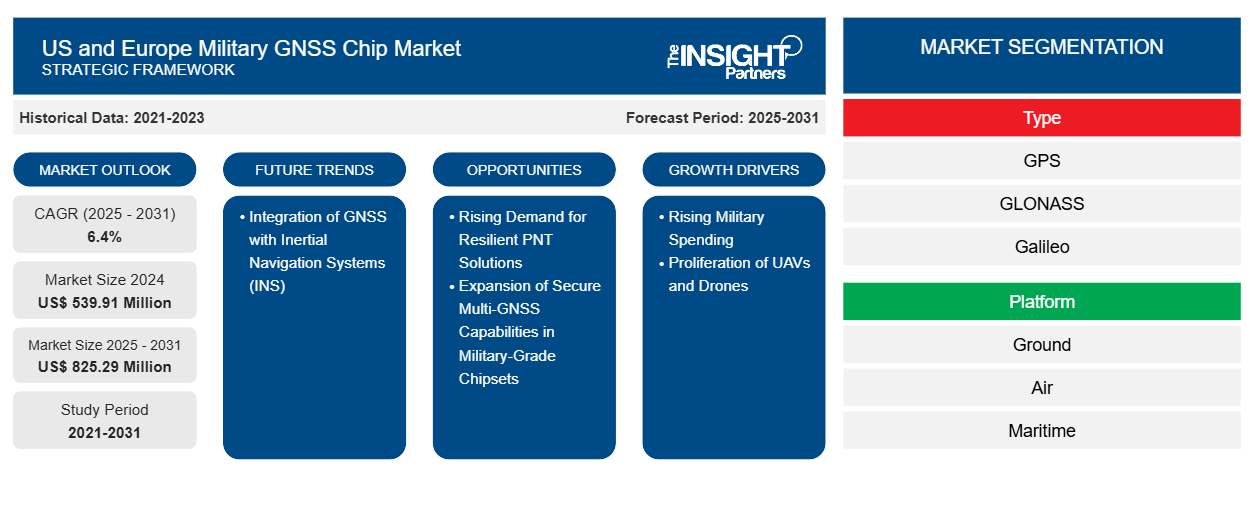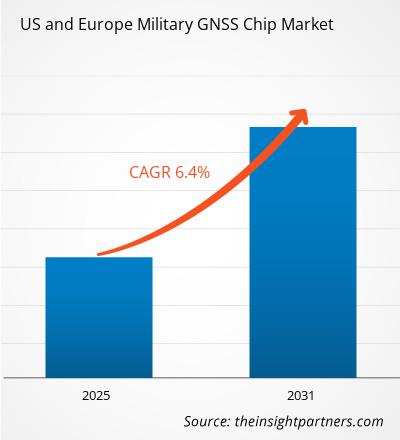美国和欧洲军用GNSS芯片市场规模预计将从2024年的5.3991亿美元增至2031年的8.2529亿美元。预计2025年至2031年期间,该市场的复合年增长率将达到6.4%。GNSS与惯性导航系统(INS)的融合可能会在未来几年为市场带来新的趋势。
美国和欧洲军用GNSS芯片市场分析
在对抗或GPS信号被拒止的环境中,对安全且具有弹性的导航解决方案的需求日益增长,这推动了具有抗干扰、防欺骗和加密信号功能的GNSS技术的应用。美国军方的M-Code和伽利略的公共监管服务就是此类功能的例子。对包括无人机、地面车辆和海事平台在内的自主和无人系统的投资不断增长,正在推动对能够支持复杂国防行动的GNSS芯片的需求。地缘政治紧张局势以及对实时态势感知和部队协调日益增长的需求,迫使国防机构对其PNT能力进行现代化和多样化改造,从而进一步刺激了需求。
美国和欧洲军用GNSS芯片市场概况
GNSS(全球导航卫星系统)芯片是集成在电子设备中的半导体元件,用于接收和处理来自 GPS(美国)、Galileo(欧盟)和 GLONASS(俄罗斯)等卫星导航系统的信号。它们提供对军事、汽车、航空和消费电子等应用至关重要的定位、导航和授时 (PNT) 信息。GNSS 接收器是处理来自多个 GNSS 信号以确定精确位置、速度和授时信息的电子设备。GNSS 模块是包含接收器和相关硬件的集成组件,旨在轻松集成到更大的系统中。在军事和国防应用中,这些接收器和模块可在多样化和具有挑战性的环境中实现精确导航、瞄准、侦察和安全通信。它以增强的精度、可靠性以及抗干扰和欺骗能力支持关键任务操作。
您可以免费定制任何报告,包括本报告的部分内容、国家级分析、Excel 数据包,以及为初创企业和大学提供优惠和折扣
美国和欧洲军用GNSS芯片市场:战略洞察

- 获取此报告的顶级关键市场趋势。此免费样品将包括数据分析,从市场趋势到估计和预测。
美国和欧洲军用GNSS芯片市场驱动因素和机遇
军费开支增加
美国现役军人近 130 万,正在投资先进的国防技术,2014 年至 2022 年期间的国防开支将超过其他 30 个北约成员国的总和。全球军事和国防部门不断增加的投资对 GNSS 芯片市场有直接影响,特别是在军事和航空航天应用领域。GNSS 芯片对国防行动至关重要。它们支持精确制导弹药、无人机 (UAV)、导弹导航、监视和安全通信系统。随着武装部队进行现代化改造并优先考虑态势感知、实时地理定位和复杂作战环境中的互操作性,对高精度、多频和防欺骗 GNSS 解决方案的需求正在加速增长。国防专用 GNSS 应用需要能够在极端条件下可靠运行的坚固耐用的芯片组,从而推动芯片架构和卫星信号集成的创新。
军用级芯片组中安全多GNSS功能的扩展
维萨拉于2024年10月31日宣布,其气象监测设备将支持多GNSS(全球导航卫星系统)并实现业界首创的消息认证,这凸显了其向更具弹性和安全性的卫星导航基础设施战略转型的决心。这些技术最初是为气象机构量身定制的,如今也应用于国防领域,尤其是在提高对军事行动和国家安全规划至关重要的大气数据的可靠性方面。多GNSS功能的引入使系统能够同时访问多个卫星星座,从而降低信号干扰带来的风险,无论是恶劣环境条件还是敌方干扰。这项技术的引入对美国和欧洲的国防部门来说是一项直接的价值主张,因为在这些领域,在GPS信号缺失的环境中保持态势感知和协调后勤的能力至关重要。维萨拉的测试表明,通过多GNSS,数据可用性提高了60%。这为军用级芯片制造商在导航和授时应用中满足国防规范树立了标杆。
维萨拉实施的消息认证技术代表着基于GNSS系统的网络安全领域的一次飞跃。军事领域对网络威胁和信号欺骗高度敏感,嵌入类似数据完整性功能的芯片将使其受益。随着对抗战术的数字化程度日益提高,采用嵌入式认证设计的GNSS芯片可以保护指挥控制系统、天气预报工具、无人机操作以及其他依赖精确地理定位和遥测的资产。
美国和欧洲军用GNSS芯片市场报告细分分析
有助于得出美国和欧洲军用 GNSS 芯片市场分析的关键部分是产品类型、扭矩、速度和最终用户。
- 根据类型,市场分为GPS、GLONASS、Galileo和其他。GPS领域在2024年占据市场主导地位。
- 按平台划分,市场分为地面、空中、海上和精确制导弹药 (PGM)。地面部分又分为手持式、便携式、车载系统和基于基础设施的。同样,空中部分又分为无人机和飞机。海上部分又分为水面舰艇、潜艇和无人海上系统。精确制导弹药 (PGM) 部分又分为导弹和火炮。2024 年,地面部分占据了市场主导地位。
- 根据应用,市场分为导航、目标跟踪、导弹和射弹制导、搜索救援、侦察、核爆炸探测器和资产跟踪(GNSS+GPRS)。导航领域在2024年占据市场主导地位。
美国和欧洲军用GNSS芯片市场份额(按地区)分析
美国和欧洲军用GNSS芯片市场主要分为美国和欧洲国家。在所有国家中,美国在2024年占据了主导地位。
美国国防部 (DoD) 目前正在升级其军事系统,通过整合先进的 GNSS 技术来提升其定位、导航和授时 (PNT) 能力。这项现代化工作旨在提高国防平台的作战效率、安全性和战略决策能力。国防部的替代 PNT 科学技术战略侧重于两个关键领域:增强传感器技术以提供精确的相对定位和导航,以及利用外部来源提供可靠的绝对位置数据。2024 年 2 月,BAE 系统公司完成了 MGUE 增量 2 项目的关键设计审查,该项目是与美国太空部队签订的价值 2.47 亿美元合同的一部分。该项目致力于开发下一代专用集成电路 (NG ASIC),以增强 M 代码能力,确保在 GPS 信号不可用或受损的环境中实现可靠的 PNT。该项目的目标是开发一种紧凑型 GNSS 接收机,可集成到各种军事平台,包括手持系统和精确制导武器。该项目计划于 2025 年完成。
2025年3月,美国陆军授权全面生产由柯林斯航空航天公司开发的MAPS第二代系统。该车载解决方案利用传感器融合算法和非射频传感器,在GPS信号受限的环境中提供可靠的PNT数据。该系统旨在在单一平台上支持多用户,从而减少了对重复GPS接收器和天线的需求。该项目的预算拨款约为5亿美元,计划在2025财年采购619套。因此,对R-GPS的此类投资推动了美国军用GNSS芯片市场的增长。
美国和欧洲军用GNSS芯片市场区域洞察
Insight Partners 的分析师已详尽阐述了预测期内影响美国和欧洲军用 GNSS 芯片市场的区域趋势和因素。本节还讨论了美国和欧洲军用 GNSS 芯片市场的细分市场以及北美、欧洲、亚太地区、中东和非洲以及南美和中美洲的地理位置。

- 获取美国和欧洲军用 GNSS 芯片市场的区域具体数据
美国和欧洲军用GNSS芯片市场报告范围
| 报告属性 | 细节 |
|---|---|
| 2024年的市场规模 | 5.3991亿美元 |
| 2031年的市场规模 | 8.2529亿美元 |
| 全球复合年增长率(2025-2031) | 6.4% |
| 史料 | 2021-2023 |
| 预测期 | 2025-2031 |
| 涵盖的领域 | 按类型
|
| 覆盖地区和国家 | 我们
|
| 市场领导者和主要公司简介 |
|
美国和欧洲军用 GNSS 芯片市场参与者密度:了解其对业务动态的影响
美国和欧洲军用GNSS芯片市场正在快速增长,这得益于终端用户需求的不断增长,而这些需求的驱动因素包括消费者偏好的演变、技术进步以及对产品优势的认知度的提升。随着需求的增长,企业正在扩展产品线,不断创新以满足消费者需求,并抓住新兴趋势,从而进一步推动市场增长。
市场参与者密度是指特定市场或行业内企业或公司的分布情况。它表明特定市场空间内竞争对手(市场参与者)的数量相对于其规模或总市值而言。
在美国和欧洲军用 GNSS 芯片市场运营的主要公司有:
- 泰雷兹公司
- BAE系统公司
- 通用动力任务系统公司
- 莱昂纳多公司
- 诺斯罗普·格鲁曼公司
- L3Harris技术公司
免责声明:以上列出的公司没有按照任何特定顺序排列。

- 了解美国和欧洲军用 GNSS 芯片市场主要参与者概况
美国和欧洲军用GNSS芯片市场新闻及最新发展
通过收集一手和二手研究后的定性和定量数据,对美国和欧洲军用GNSS芯片市场进行评估。这些数据包括重要的公司出版物、协会数据和数据库。以下列出了美国和欧洲军用GNSS芯片市场的一些发展情况:
- 欧洲领先的弹性导航公司泰雷兹宣布投资5500万欧元,用于强化其位于法国沙泰勒罗和瓦朗斯的工业基地。这项投资将于2025年至2028年间完成,旨在满足日益增长的民用和军用高性能导航解决方案需求,并增强其自主和尖端的工业基础。
(来源:泰雷兹,新闻稿,2025 年 3 月)
- L3Harris Technologies 公司与美国太空部队太空系统司令部签订了合同,负责设计弹性全球定位系统 (R-GPS) 项目第 0 阶段的概念。R-GPS 项目旨在采购高性价比的小型卫星,以增强现有的 31 颗 GPS 卫星星座。该项目旨在为军用和民用 GPS 用户提供弹性保障。太空部队计划生产并发射最多 8 颗卫星,以应对干扰、欺骗和更持久的干扰。
(来源:L3Harris Technologies,新闻稿,2025 年 1 月)
美国和欧洲军用 GNSS 芯片市场报告覆盖范围和交付成果
《美国和欧洲军用GNSS芯片市场规模及预测(2021-2031)》对以下领域进行了详细的市场分析:
- 美国和欧洲军用 GNSS 芯片市场规模以及区域和国家层面涵盖的所有关键市场领域的预测
- 美国和欧洲军用 GNSS 芯片市场趋势,以及驱动因素、限制因素和关键机遇等市场动态
- 详细的 PEST 和 SWOT 分析
- 美国和欧洲军用 GNSS 芯片市场分析涵盖主要市场趋势、区域框架、主要参与者、法规和最新市场发展
- 行业格局和竞争分析,涵盖市场集中度、热图分析、知名参与者以及美国和欧洲军用 GNSS 芯片市场的最新发展
- 详细的公司简介
- 历史分析(2 年)、基准年、预测(7 年)及复合年增长率
- PEST和SWOT分析
- 市场规模、价值/数量 - 全球、区域、国家
- 行业和竞争格局
- Excel 数据集
近期报告
客户评价
购买理由
- 明智的决策
- 了解市场动态
- 竞争分析
- 客户洞察
- 市场预测
- 风险规避
- 战略规划
- 投资论证
- 识别新兴市场
- 优化营销策略
- 提升运营效率
- 顺应监管趋势






















 获取免费样品 - 美国和欧洲军用GNSS芯片市场
获取免费样品 - 美国和欧洲军用GNSS芯片市场